Because of the confusion between the terms ‘hair thickness‘ and ‘hair density’, sometimes you may get stuck wondering whether your hair is thick or if it’s thin. Both present different problems when it comes to styling and products, but they’re manageable.
If you want to learn a little more about how thick hair behaves and what you can do to tame it a bit, or how thin hair behaves and you want to get that extra body, stay tuned! Let’s discuss the differences between thick hair and thin hair so that you can identify them better.
Hair Types and Textures
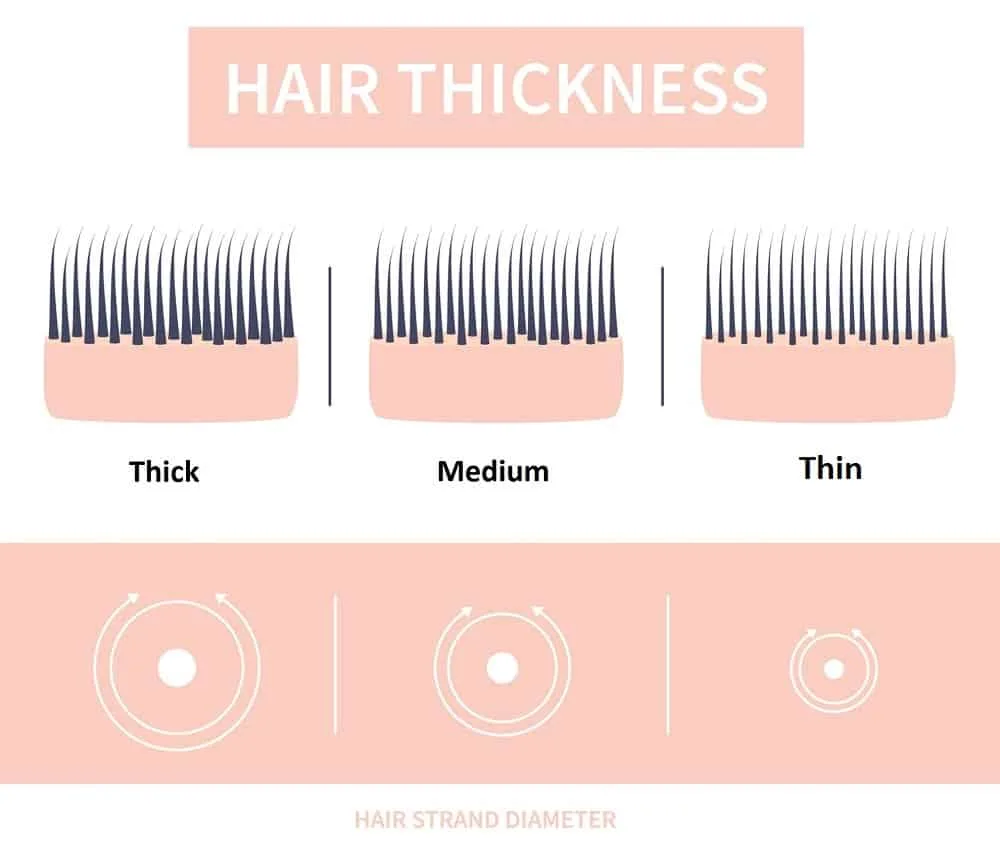
Thick hair is an indication of how wide a strand of your hair is. More often than not, people are talking about hair density, thinking they’re talking about how thick their hair seems to be.
The density is how much hair you have on your head, as in per square inch, how many strands do you have on your head?
So remember, hair thickness refers to your strands, and hair density refers to how much hair you have.
If you find that a strand of your hair is less than the width of a standard piece of thread, then you likely have thin hair. If you found that in addition to having thin hair, you also just don’t have a whole lot of hair on your head in general, this would be called having fine hair.
Typically, if you can see your scalp pretty easily when you look in the mirror, your hair is probably fine, and you can have different combinations of hair types.
It’s not uncommon that someone can have thin, coarse hair or fine hair that’s dense.
Thick Vs. Thin Hair: A Comparison
Hair Diameter
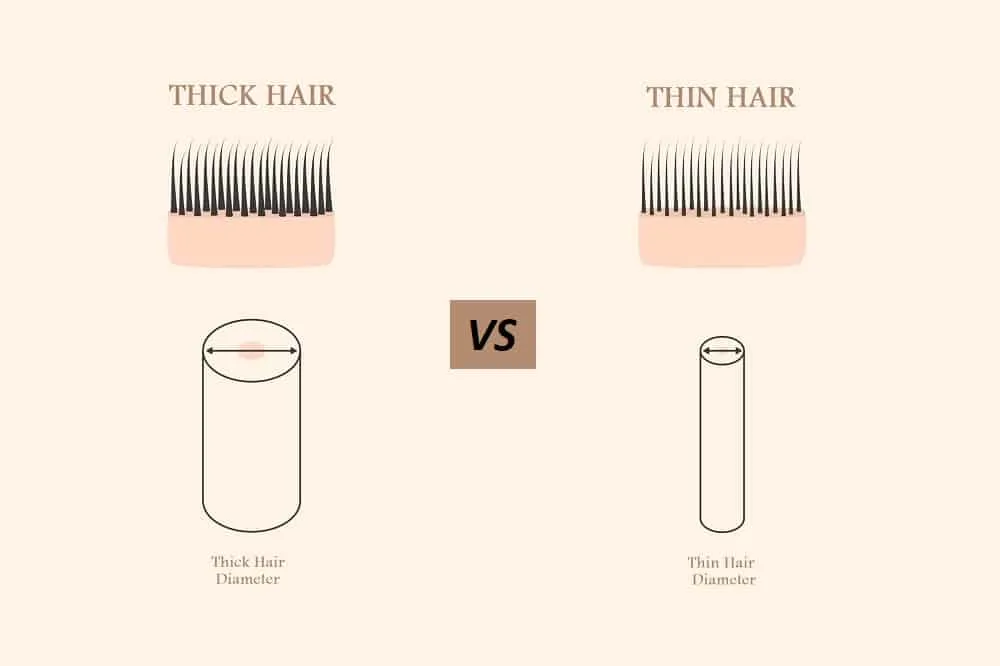
Let’s discuss the diameter of your strands and the appearance of your hair.
- Your hair strand feels coarse when you touch it
- The diameter of your hair strand equals 120 microns
- Your hair strands are visible, and you can’t see your scalp easily
- The median thickness of your hair strands is between 0.08 and 1 millimeter
Now, let’s contrast that with how your hair would look and feel if it’s thin.
- You can’t feel a single strand of hair between your fingers
- The texture of your hair strand is smooth and soft even though you can barely feel it
- You can hardly see a strand of hair when you look at one directly
- The diameter of your hair strand equals 50 microns
- The median thickness of your hair strands is between 0.04 and 0.06 millimeters
Are Your Follicles Close Together or Far Apart?
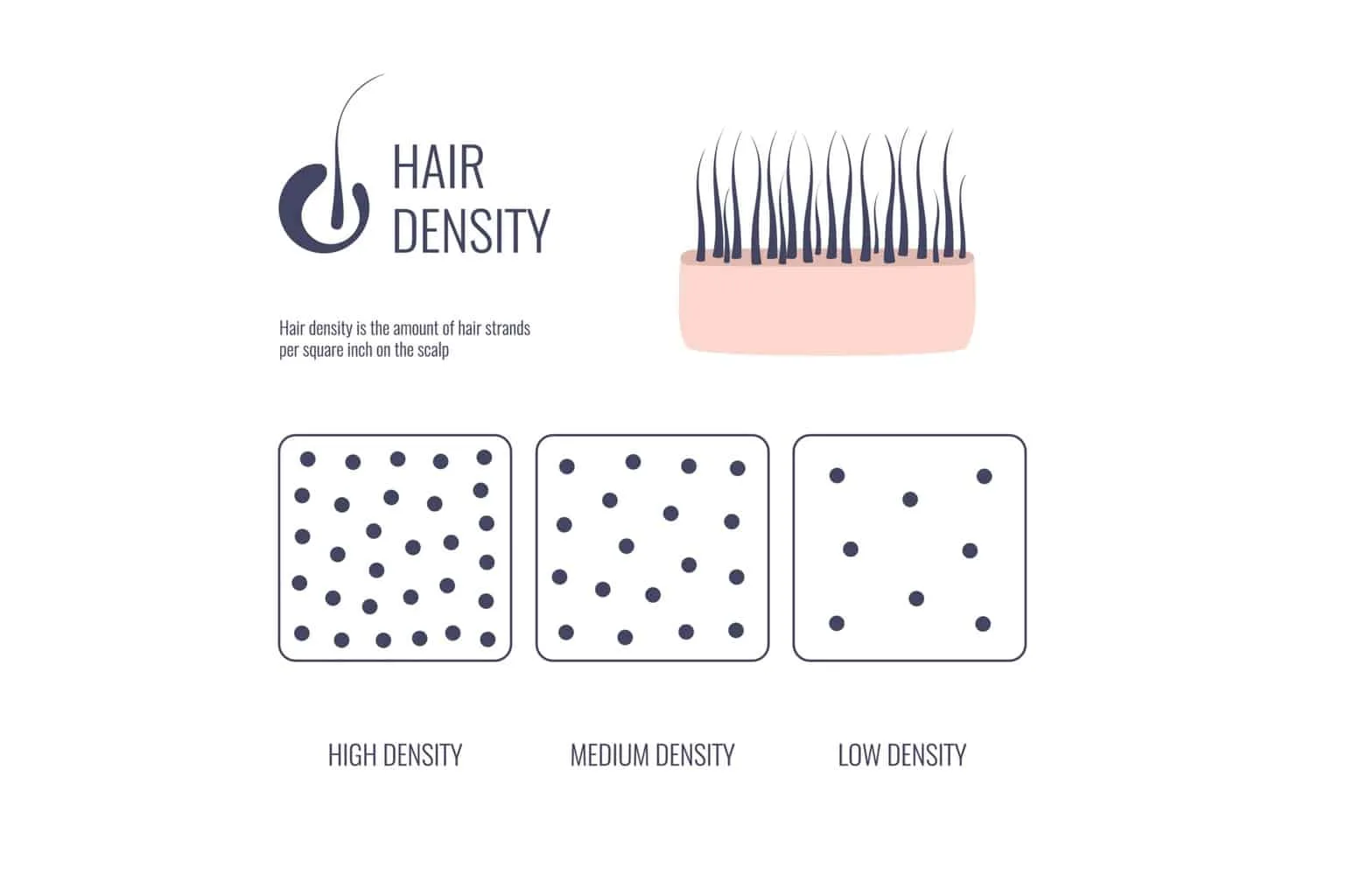
Think of your hair follicles as tiny little pockets that are all over your scalp, and they house the roots of your hair, and your stands sprout from underneath your scalp. The density and texture of your hair are dependent upon the size of your hair follicles.
Thick hair:
- Hair follicles are large
- More hair follicles for every square inch of your scalp
Thin hair:
- Hair follicles are small
- Fewer hair follicles for every square inch of your scalp
How Density Factors Into Hair Type
If you want to know whether you have dense hair, you can use a hair tie to make a ponytail near the crown of your head. From there, you can measure the circumference.
Thick hair: The ponytail circumference is over two inches.
Thin hair: The ponytail circumference is less than two inches.
Hair Strands & Width
The term hair width refers to how thick a strand of your hair is, also known as the circumference.
Thick hair:
- Large circumference
- Easy to see an individual strand
Thin Hair:
- Small circumference
- You can hardly see an individual strand
How Can I Measure Hair Thickness?
Perform these simple tests to see if you have thick hair:
Try the Strand Test
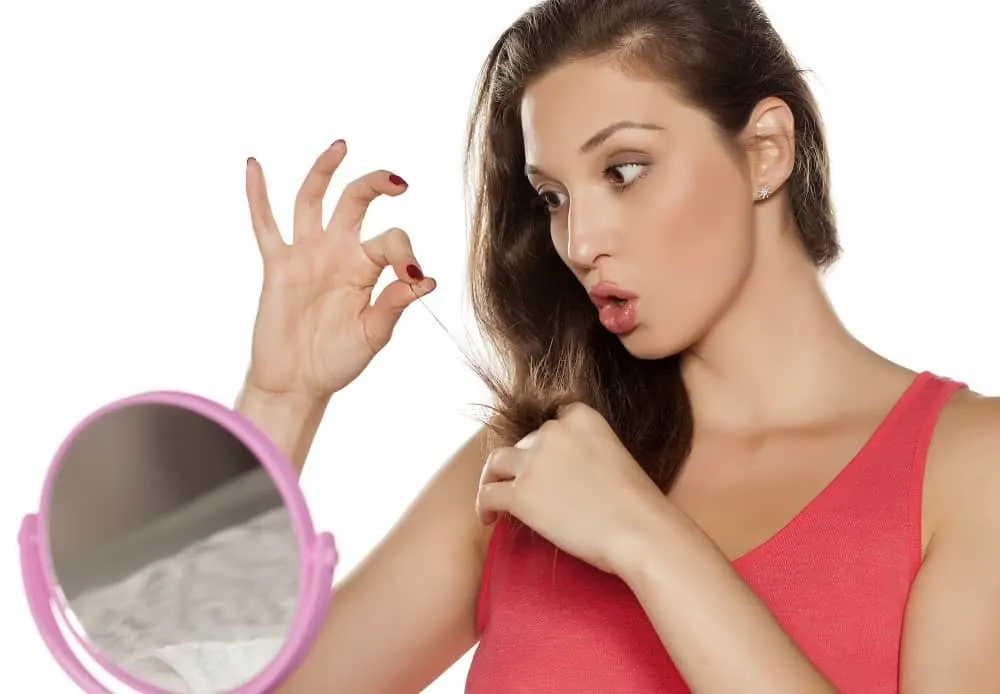
You might be able to determine if your hair is thick in the comfort of your own home by simply plucking (or grabbing one from the comb), a strand of your hair.
- Hold this strand of hair between your fingers.
- If you notice that you can’t feel the strand of hair on your finger, or barely see it for that matter, then you have thin hair.
- If you can feel it somewhat, you may have medium hair.
- If you can tell that the strand is there and it feels rough, you have a thick hair texture.
Try the Thread Test
Take one strand of hair and put it next to a piece of thread.
Is your hair strand thinner than the piece of thread? That means you have fine hair; if it’s the same thickness then you have medium hair, and if it’s thicker, then your hair is thick.
Difference Between Thin And Fine Hair
A lack of volume and seeing your scalp, meaning that the follicles are far apart, makes your hair feel and look thin.
Having fine hair speaks to the diameter of one hair. It’s usually silky and smooth, and it doesn’t necessarily mean that your hair is thin. It’s more susceptible to breakage, and it is feathery and lightweight.
But that doesn’t mean that you don’t have a lot of hair on your head or that you can see your scalp well when you look in the mirror.
Both thick and thin hair present their own challenges when it comes to styling them. Below are the common problems with both.
Hair Problems: Thick vs Thin Hair
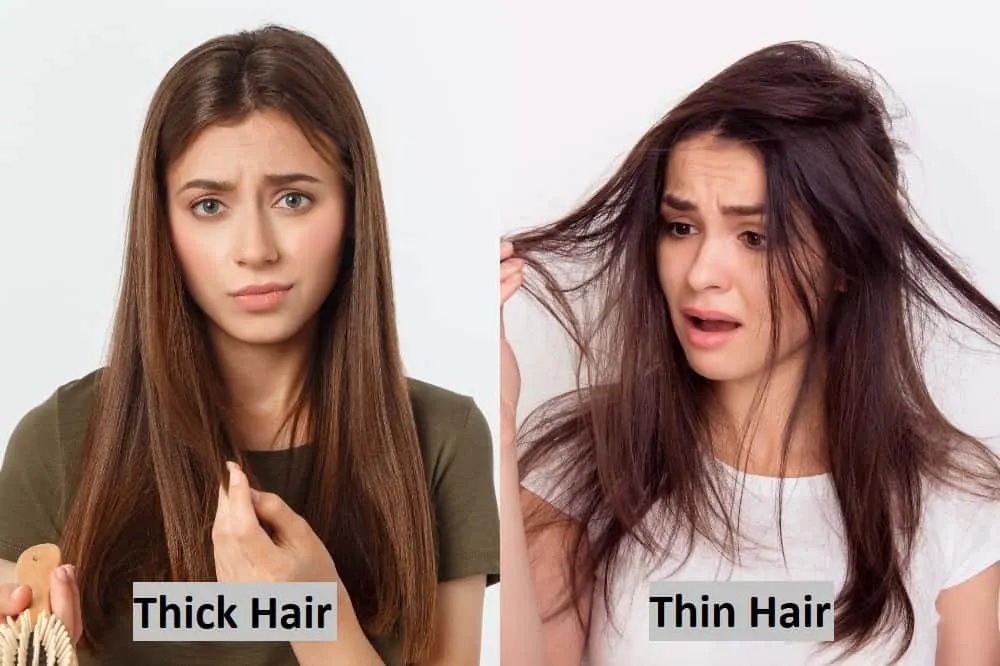
Having thin hair makes styling a ponytail difficult. Rubber bands and clips tend to slip due to the likely fine texture of your hair.
Another problem could be that the circumference of the ponytail happens to be too small to tie it tightly. You may spend precious time curling your hair only to see them become flat in about an hour.
Your hair may even seem to grow slower. Your hair will even begin to feel greasy if you so choose to condition it with regularity. And the last problem that you may face with thin hair is scalp sunburn which hurts to no end!
On the other hand, if you have thick hair then you already know that it is prone to tangling and can feel virtually impossible to brush or comb it without feeling as if you’re pulling your scalp off.
To properly tie up thick hair, you will need the prerequisite accessories. Another challenge is that it takes a while to air dry or even blow dry thick hair.
With this hair, keeping shampoo and conditioner on hand is a must. And when it comes to coloring your hair, you will need multiple boxes of dye to dye your locks. Finally, you will notice that you will find your hair any and everywhere!
In a nutshell, it is challenging to manage both types of hair, and you will have to put your best foot forward to get the job done.
How To Thin Out Your Thick Hair
Choose a hair treatment for your thick hair:
Begin by applying a moisturizing spa treatment or hair mask to control the thickness of your hair and give your hair that smooth and shiny look.
You can also use a smoothing conditioner and shampoo to make your hair appear thin.
Be sure to wash your hair with cold water because washing your hair with hot water zaps your hair off the essential oils that come from the scalp, which will make your hair frizzy or dry.
You can apply the hair cream before blow-drying your hair. That won’t weigh your hair down, and it won’t be greasy either!
Also, try grabbing yourself a quality flat iron for a sleeker and smoother look.
Again both thin and thick hair comes with their very own challenges when it comes to styling them. However, with these hair care and maintenance tips, you can preserve the look and health of your hair.
How To Make Your Thin Hair Look Thicker

For starters, you can begin with trimming your hair to give your hair the illusion of being thicker. Cut a couple of inches off and create some layers to give your hair the illusion of more volume. Using volumizing shampoo will also help to add volume to thinner hair.
When blow-drying your hair, use a variety of volumizing styling products. Furthermore, you can even use some lightweight mousse to achieve a bouncier that lasts for a while.
Look into getting the right hairbrush that can help add volume to your hair. For example, a brush made of boar bristles is gentle on the scalp and gives volume to those with thin hair.
Lastly, you can spray dry shampoo onto the roots of your hair to clean your mane to add volume without over saturating your hair and making it greasy.
When it comes to the ponytail, you can tie it with multiple hair ties to create a double pony, which gives it a more voluminous look.
If you’ve been having problems managing your thick locks and you wish to make them smooth and shiny, below is the solution to your problems.
Final Thoughts
Finally, remember that thick and thin hair doesn’t have to do with how many strands of hair you have on your scalp. These terms actually refer to the diameter of your hair strands and their effect on the look of your hair, whether it’s full or thin.
Additionally, if you wish to manage thicker or thinner hair, use the beauty hacks outlined in this article to properly manipulate your hair to give it the look that you’ve always wanted!
You May Also Like:
